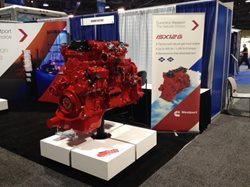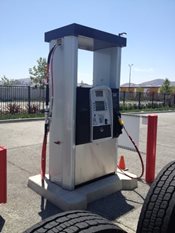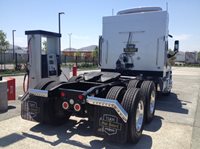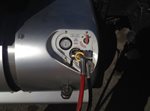 A question was recently asked of me regarding any problems I may have faced after driving my CNG truck for just over 11,000 miles now. When it comes to performance, there is absolutely nothing to complain about! My Cummins Westport ISX12-G and Allison 4000 six-speed automatic transmission have been a great combo to power my Freightliner Cascadia and made it an absolute pleasure to drive. The quietness of the cab interior and superb handling of the Cascadia have really made an impact on my long workdays here in Southern California. I did however think of a common problem that stems from the fueling network for CNG fuel itself, but it is not the problem most think of when it comes to CNG.
A question was recently asked of me regarding any problems I may have faced after driving my CNG truck for just over 11,000 miles now. When it comes to performance, there is absolutely nothing to complain about! My Cummins Westport ISX12-G and Allison 4000 six-speed automatic transmission have been a great combo to power my Freightliner Cascadia and made it an absolute pleasure to drive. The quietness of the cab interior and superb handling of the Cascadia have really made an impact on my long workdays here in Southern California. I did however think of a common problem that stems from the fueling network for CNG fuel itself, but it is not the problem most think of when it comes to CNG.
 When most people think of CNG fueling, they think of a lack of actual stations available to get fuel at, which is true in many areas to a certain extent. As the network of fueling stations increases, more and more people are gaining access to this fuel supply. Here in Southern California, we happen to have one of the largest and most accessible networks, thanks to the CNG automobile boom over the past decade. Before big trucks starting fueling at public CNG stations, this fuel source was mainly pioneered by taxicabs, city/state/county municipal vehicles and public transit busses. Where most bus companies installed their own private fueling stations, the rest of the users relied heavily on private/public partnerships for their fueling stations. These stations did the job well of providing a much needed network of fueling for CNG vehicles here in California, but were designed to pump out much smaller quantities of fuel than what is used by the big trucks fueling in today’s CNG market. This being the case, compressors at these stations that are relied on for pushing the CNG into the tanks are not adequate for the large volume needed for rigs. A lot of the compressors are now being overworked, causing them to be very slow and even break down. I caution anyone in a CNG truck to excercise caution when using some of these older/smaller stations, as a serious problem has been uncovered in using them. A common problem that is becoming more prevalent and feared in the CNG community is the leaking of oil from these problem compressors, which then enters into your truck’s CNG fuel system. Even though there are filters on the engine that are drained daily for just this problem, issues are still arising from failure to do so and continued usage of these problem pumps. This presence of oil in your CNG fuel can lead to a very, very costly fix on your engine!
When most people think of CNG fueling, they think of a lack of actual stations available to get fuel at, which is true in many areas to a certain extent. As the network of fueling stations increases, more and more people are gaining access to this fuel supply. Here in Southern California, we happen to have one of the largest and most accessible networks, thanks to the CNG automobile boom over the past decade. Before big trucks starting fueling at public CNG stations, this fuel source was mainly pioneered by taxicabs, city/state/county municipal vehicles and public transit busses. Where most bus companies installed their own private fueling stations, the rest of the users relied heavily on private/public partnerships for their fueling stations. These stations did the job well of providing a much needed network of fueling for CNG vehicles here in California, but were designed to pump out much smaller quantities of fuel than what is used by the big trucks fueling in today’s CNG market. This being the case, compressors at these stations that are relied on for pushing the CNG into the tanks are not adequate for the large volume needed for rigs. A lot of the compressors are now being overworked, causing them to be very slow and even break down. I caution anyone in a CNG truck to excercise caution when using some of these older/smaller stations, as a serious problem has been uncovered in using them. A common problem that is becoming more prevalent and feared in the CNG community is the leaking of oil from these problem compressors, which then enters into your truck’s CNG fuel system. Even though there are filters on the engine that are drained daily for just this problem, issues are still arising from failure to do so and continued usage of these problem pumps. This presence of oil in your CNG fuel can lead to a very, very costly fix on your engine!
 When fueling CNG, one of the most important things to remember is that price may not fully dictate the best place to fuel. This is true in diesel applications as well, as many have learned the hard way, an unbelievably cheap price can often lead to poor fuel quality. My primary fueling station is a moderately priced station for the area, not being the lowest price or the highest, but being right in the middle. It is a new pump, with a compressor designed for pumping large volumes of CNG for many of their leased CNG tractors, but being open to public customers like myself as well. Before learning of this growing problem of station compressor oil getting into the fuel, I was guilty of fueling at a couple of the “sketchier” stations and have since steered far away from them, as their slow fill times and poorly maintained equipment were key indicators of what might be in store if I continued using their station.
When fueling CNG, one of the most important things to remember is that price may not fully dictate the best place to fuel. This is true in diesel applications as well, as many have learned the hard way, an unbelievably cheap price can often lead to poor fuel quality. My primary fueling station is a moderately priced station for the area, not being the lowest price or the highest, but being right in the middle. It is a new pump, with a compressor designed for pumping large volumes of CNG for many of their leased CNG tractors, but being open to public customers like myself as well. Before learning of this growing problem of station compressor oil getting into the fuel, I was guilty of fueling at a couple of the “sketchier” stations and have since steered far away from them, as their slow fill times and poorly maintained equipment were key indicators of what might be in store if I continued using their station.
 Be sure to time your fills when fueling, which is a key indicator that a station has the right sized compressor for your needs. Getting a pump speed of 8-12 gallons per minute is a good indicator that a station has the right stuff going for them to fuel large trucks without a problem. Also, make it a habit to drain your fuel filters that run any trace oil out of the system daily, as recommended by your owner’s manual. If you start to see traces of oily sludge that may be white in color coming from the bottom of these drain valves, discontinue use of your most recent fueling station and see if it makes a difference. Use your observation skills as
Be sure to time your fills when fueling, which is a key indicator that a station has the right sized compressor for your needs. Getting a pump speed of 8-12 gallons per minute is a good indicator that a station has the right stuff going for them to fuel large trucks without a problem. Also, make it a habit to drain your fuel filters that run any trace oil out of the system daily, as recommended by your owner’s manual. If you start to see traces of oily sludge that may be white in color coming from the bottom of these drain valves, discontinue use of your most recent fueling station and see if it makes a difference. Use your observation skills as  well, to monitor the appearance of the pump equipment in general. This will be one of the first things to tip you off that a station may start looking run down because the upkeep and maintenance are not quite what they need to be for a station. By practicing these fueling habits and knowing what to look for, you too can help keep your truck’s fuel system running problem-free for miles to come.
well, to monitor the appearance of the pump equipment in general. This will be one of the first things to tip you off that a station may start looking run down because the upkeep and maintenance are not quite what they need to be for a station. By practicing these fueling habits and knowing what to look for, you too can help keep your truck’s fuel system running problem-free for miles to come.